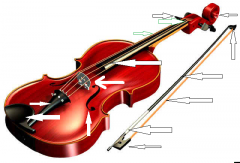![]()
![]()
![]()
Use LEFT and RIGHT arrow keys to navigate between flashcards;
Use UP and DOWN arrow keys to flip the card;
H to show hint;
A reads text to speech;
34 Cards in this Set
- Front
- Back
|
At the point
|
Play only near the tip of the bow
|
|
|
At the frog
|
Play only near the frog, the bottom, of the bow
|
|
|
Sul Tasto
|
To bow over the fingerboard
|
|
|
Sul Ponticello
|
To bow as close to the bridge as possible
|
|
|
Sul (C), G, D, A, E
|
To play the passage only on the specified string
|
|
|
Scordatura
|
out of tune; i.e., an alternative tuning used for the strings of a string instrument
|
|
|
Spiccato
|
distinct, separated; i.e., a way of playing the violin and other bowed instruments by bouncing the bow on the string, giving a characteristic staccato effect
|
|
|
Double stops
|
the technique of playing two notes simultaneously on a bowed string instrument
|
|
|
Pizzacato
|
To pluck a string
|
|
|
Up bow symbol
|
V
|
|
|
Down bow symbol
|
π
|
|
|
Trills
|
a musical ornament consisting of a rapid alternation between two adjacent notes, usually a semitone or tone apart
|
|
|
Jete
|
the bow is thrown on the string, and then bounces for several notes in the same bow direction
|
|
|
Martele
|
"hammered" Each note is percussive, and commences with a sharp accent or "pinch" at the beginning of the note, followed by a quick release.
|
|
|
Loure
|
a short series of gently pulsed legato notes executed in one bow stroke (it is also known as portato)
|
|
|
Staccato
|
Staccato indicates the bow should remain on the string to play shortened and detached notes, distinctly separate from successive notes
|
|
|
Detache
|
Détaché indicates smooth, separate bow strokes should be used for each note (it does not mean detached or disconnected). Notes are of equal value, and are produced with an even, seamless stroke with no variation in pressure.
|
|
|
Legato
|
Legato indicates the notes should be smoothly connected, played either in one or several bows (slurs are often used with the legato bow stroke).
|
|
|
Divisi
|
a part in which several musicians normally play exactly the same notes they are instead to split the playing of the written simultaneous notes among themselves.
|
|
|
Portamento
|
generally, sliding in pitch from one note to another, usually pausing just above or below the final pitch, then sliding quickly to that pitch.
|
|
|
Arpeggiando (a.k.a. arpeggiato)
|
a way of playing a chord: starting with the lowest note, and with successively higher notes rapidly joining in. Sometimes the effect is reversed, so that the highest note is played first.
|
|
|
Col Legno
|
To hit the string with the wood of the bow
|
|
|
Glissando
|
a continuous sliding from one pitch to another
|
|
|
Strings on a Double Bass and their Roman numerals
|
E(IV) A(III) D(II) G(I)
|
|
|
Strings on a Cello and their Roman numerals
|
C(IV) G(III) D(II) A(I)
|
|
|
Strings on a viola and their Roman numerals
|
C(IV) G(III) D(II) A(I)
|
|
|
Strings on a violin and their Roman numerals
|
G(IV) D(III) A(II) E(I)
|
|
|
Why may a double stop not be possible?
|
-notes are out of the range
-the two notes can only be played on the same string -the notes can not be played on adjacent strings (such as A3 on the G string and C5 on either the D or A string) |
|
|
What are natural harmonics? How are they played?
|
Produced on open strings, they resonate with the harmonic series of the open string, they are played by very lightly touching the string. These sound the pitch of where the string is touched.
|
|
|
What is an artificial harmonic? How are they played?
|
Artificial harmonics are harmonics played by changing the string length. This is played by pressing down hard with one finger and a 4th above it, lightly touching the string. This pitch sounds 2 octaves above the note that is pressed down hard.
|
|

Parts of the instrument
|
Violin top to bottom:
-scroll -peg box -pegs -nut -neck -fingerboard -bridge -f-holes -fine tuners -tail piece -violin/viola: chin rest -Cell/bass have endpins (not in image) Bow top to bottom -Tip (head) -stick/wood -horse hair -winding -frog -screw (no arrow on diagram, is the very bottom part) |
|
|
Put on a mute in Italian, French German
|
-con sordino
-con sourdine -mit Dämpfer /Dämpfer auf |
|
|
Take off a mute in Italian, French, German
|
- senza sordino
-senza sourdine - ohne Dämpfer (Dämpfer ab/weg) |
|
|
Types of tremolos
|
Bowed Tremolo: repeating a single pitch as fast as possible with as many bow strokes as possible
Fingered Tremolo: similar to a trill where you change pitch, but it can be pitches farther than a step apart and can also use bowed tremolo technique |

